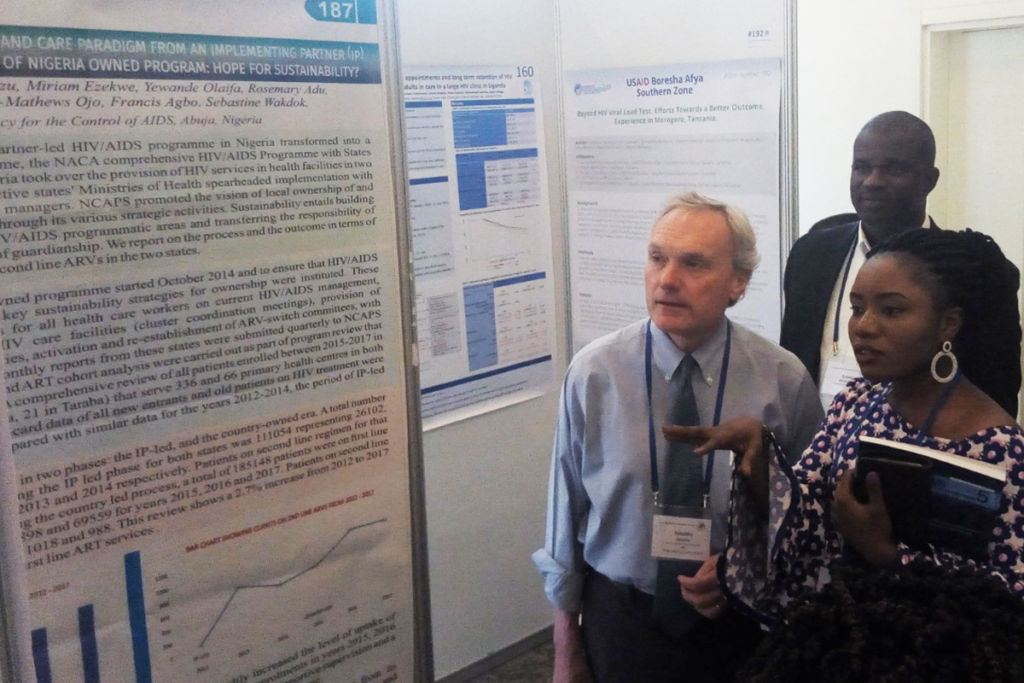Sub-Saharan Africa is home to 26 million (70 percent) of the global total of 37 million people living with HIV infection. To control the epidemic in Africa, it is essential that solutions for Africa be generated and implemented in Africa. The INTEREST Conference – known as the “African CROI” – is a great example of international cooperation intended to advance the fight against HIV in Africa by cultivating African scientists and stimulating innovative solutions on the continent.
In 2007, a group of scientists, led by Elly Katabira from Uganda and Joep Lange from Amsterdam, launched the INTEREST Conference (International Conference on HIV Treatment, Pathogenesis and Prevention Research in Resource-Limited Settings) in Kampala, Uganda, to focus attention on the need for research and evidence to fight the HIV epidemic and address the shortage of HIV research capacity in Africa. INTEREST started off as an intimate gathering of about 200 scientists from Africa and other countries with a focus on stimulating African scientists to present their work, highlighting gaps in knowledge and application, and an explicit emphasis on mentoring. This year, during May 29–June 1, the 12th INTEREST Conference was held in a gleaming new conference center in Kigali, Rwanda, and included more than 600 people from 32 countries.
The 4-day agenda was packed and dynamic. The Hon. Diane Gashumba, the Government of Rwanda’s Minister of Health, welcomed us to Kigali and set the stage for an exciting solutions-oriented meeting. The first session highlighted the remarkable job that Rwanda has done in controlling the epidemic. Due to strong political commitment, a focused health system, and good organization, Rwanda is well on its way to HIV epidemic control by nearly achieving the UNAIDS 90-90-90 targets. During her presentation, Jeanine Condo, Director General of the Rwanda Biomedical Center, reported Rwanda has identified 88 percent of those with HIV infection through testing, 94.4 percent of those infected have started antiretroviral therapy, and 91 percent have achieved viral suppression.
The agenda included an entertaining debate on a current hot issue, with this resolution: It is the responsibility of research funding organizations and researchers to ensure access, uptake, and adherence to free, onsite, oral HIV pre-exposure prophylaxis as the standard of care for all participants at risk for HIV infection in all HIV prevention clinical trials. Helen Rees from Johannesburg and Imelda Mahaka from Zimbabwe argued for this statement, while Linda-Gail Bekker from Cape Town and Jacqueline Wambui Mwangi from Kenya debated against. A vote taken among the audience prior to the debate indicated that a majority favored the resolution; however, following the debate, the audience shifted more to the “against” viewpoint, largely due to the potentially unrealistic expectation of “ensuring access, uptake and adherence.”
There was a special session moderated by UNICEF’s Chewe Luo inserted into the agenda on short notice to discuss new data from a study in Botswana that found four cases of neural-tube birth defects among babies born to 426 women taking the antiretroviral agent dolutegravir, an integrase strand-transfer inhibitor, at the time of conception. This observation of about 1 out of 100 babies with these defects is approximately 10 times more than expected. Tendani Gaolathe from Botswana and Nathan Ford from the World Health Organization (WHO) provided insight into how the study was conducted, the current thinking about interpretation of these preliminary data, likely sources of additional data, and the possible way forward to resolving the uncertainty about what these data mean about a possible causal association between exposure to dolutegravir and this type of birth defects. Guidance has been provided by WHO, the U.S. Food and Drug Administration, and the European Medicines Agency.
The conference had a very strong session on implementation science, the discipline that examines how to move from what we know works to getting it done (see this related blog post from FHI 360’s Theresa Hoke). Nicolette Naidoo from South Africa provided a clear and comprehensive review of the key elements of implementation science and then offered examples of success and considerations for new technologies and programming. She presented the example of the Rwandan delivery platform for HPV vaccines as an example of implementation success and went on to propose how implementation science can be used to advance the impact of PrEP programs. Implementation science is critical to overcoming the barriers that have so far prevented us from stopping HIV transmission and controlling the epidemic.
The conference organizers invited Mark Dybul to give a plenary speech. Dybul, now from Georgetown University, is the former head of the Global Fund to Fight AIDS, Tuberculosis and Malaria, and before that, the head of the U.S. Office of the Global AIDS Coordinator (which oversees PEPFAR). He provided a sobering perspective on the pressing need to sustain, and enhance, current HIV control efforts, lest we risk losing the gains made to date. Dybul noted that stopping HIV transmission among young people in Africa has been the greatest barrier to epidemic control. Rates of HIV testing and linkage to care and treatment are relatively low among young people, resulting in high rates of HIV transmission. The current demographic increase in the size of the young population (less than 25 years old) in Africa (the “youth bulge”) will pose a serious threat to achieving epidemic control. Dybul proposed that young people in Africa are best able to find solutions to what works for them and advocated for empowering these young people to lead the response to the epidemic.
The 12th INTEREST Conference ended with reflections from the conference chairs, Sabin Nsanzimana (Rwanda), Catherine Hankins (Montreal and Amsterdam) and Elly Katabira (Uganda) on the way forward for the fight against HIV and the critical role of African scientists in finding solutions to control the epidemic. Dr. Katabira has been a constant throughout the 12-year history of INTEREST. I’ve had the privilege of serving on the Organizing Committee and being involved since 2007 and look forward to the 13th INTEREST Conference at a site to be announced soon.
Photo credit: Edward Oladele/FHI 360



